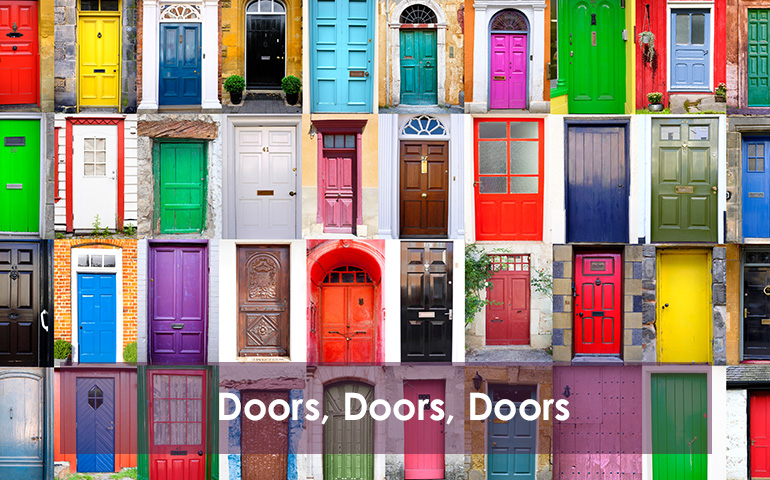
Doors, Doors, Doors
by Chris Petry
Doors. We all have them. We pass through dozens of them, day in and day out. You exit your bedroom door in the morning to shower or make breakfast, often times after you’ve opened a closet door to retrieve what you’re wearing for the day. You lock the front door of your home before exiting, unless it’s never been unlocked and you leave via integral garage. At which point you’ll enter your car, via a door of course, and hit the button on a fancy little remote to open the rolling garage door. Doors are so commonplace in our daily lives we forget they are there entirely. Unless of course the battery in that fancy little remote is dead and you have to step out of the car to hit the wall switch. Curse you door!
Current archaeological evidence suggests that among the great innovations of Ancient Egypt, was the door. Since then, doors have been altered, customized, and implemented in a variety of situations the world over. From private residences to businesses to crypts. Today, however, we’d like to highlight the most common types of doors you’re likely to find in your humble abode.

French Doors- I’m sure someone somewhere has compiled statistics related to the number of home listing descriptions that include a reference to French Doors. Rather than tracking that data down or throwing out an arbitrary number, let’s just say the number is… a lot. French Doors date back to the Renaissance period and their attractive glass-framed double-door design is just as popular with homeowners today as it was 500 years ago. In a home you’re most likely to find French Doors opening to the deck or patio but home offices and libraries are not out of the question.

Barn Doors- Sliding barn doors have been around for centuries but their popularity definitely skyrocketed in the 21st century. Of course, today, they exist within homes more for aesthetics than utility. What was once a clever design allowing for expedient access to livestock’s quarters, has become a defining feature of youthful suburban chic. These days barn doors are likely to show up as optional room partitions, at the entry of an ensuite bath, or adding extra gravitas to a playroom or home gym.

Pocket Doors- Also known as a sliding door, pocket doors are distinguished by their ability to covertly disappear into the wall when needed. In a way, they’re barn doors with hidden sliders. The installation of a single or set of pocket doors is contingent on there being enough wall space on either side of the door frame to accommodate the retreating doors. Pocket doors can really come in handy, especially for small powder rooms, utility closets, and kitchen pantries.

Dutch Doors- Dutch doors have mostly fallen out of fashion in new constructions stateside but defenders will tell you they still have their place. For instance, if you have animals or small children who might complicate the experience of handing off or receiving packages and goods to someone on the other side of the door. In case you’re not familiar, Dutch Doors open at a horizontal seam, allowing the top half of the door to remain open while the bottom is safely closed. Again, not so common these days but the novelty of it might add just the right amount of quirkiness for the right homeowner. Where would you place a Dutch Door? You’ll usually find Dutch Doors at the rear entry of the house, in kitchens, or barns.

Sliding Doors- Sliding Doors are probably the most popular option for deck, sunroom, and patio entry. What differentiates them from, say, a sliding barn door or pocket door is that they slide along a concealed track, layer on top of a fixed glass surface, and are often coupled with a secondary screen door. Most of the time, sliding doors exist for speedy access to an outside recreational space.

Standard Hinged Doors- This is the most common and secure door in use in homes and businesses today. They provide full coverage of the doorway, maximizing privacy, and can be composed of hardwood, metal, or fiberboard. They may or may not include a window and can be opened via conventional twist knob, handle, or electronic switch. The door is held to the frame by a minimum of two hinges and may include a key-only locking mechanism. You’ll find them at the main entrance of most homes and businesses, on bedrooms and privates offices, at the top of basement stairwells, and on hall storage and broom closets.

Folding Doors- Folding doors are most usually used to conceal congested or unsightly spaces within homes, such as clothing and shoe closets, small laundry rooms, and kitty litter boxes. Since they’re not usually designed for privacy or protection from the elements, they are often constructed out of lightweight slatted wood, aluminum, vinyl, or plastic.

Rolling Doors- Rolling doors usually retract via electronic command but can be pulled up or down by hand when needed. Obviously, doors of this nature are primarily designed to cover vehicle wide door frames opening to the outside. So, you’ll probably only see rolling doors on your garage or maybe an ATV, tractor, or farm storage shed.
Work with a general contractor or new home builder to customize doors to your individual needs. Before you do that, be sure to start a rapport with a knowledgeable real estate professional at your local branch of Berkshire Hathaway HomeServices Stouffer Realty.





